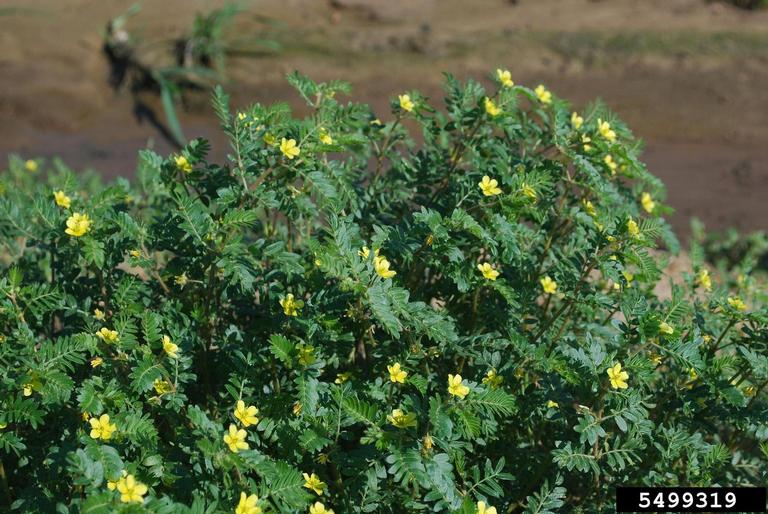a northern arizona homeowner's guide to identifying and managing invasive plants
GOATHEAD
Common name(s): Goathead, puncturevine
Scientific name: Tribulus terrestris
Family: Caltrop family (Zygophyllaceae)
Reasons for concern: This plant easily outcompetes native plants, resulting in dense monocultures and a reduction in native plant diversity very important to wildlife and pollinators. The seeds germinate quickly and can lie dormant in the soil for many years, prolonging the life of an established population. Sharp burrs cause serious injury to people, pets, wildlife, bicycle and vehicle tires, and livestock, and are easily spread by vehicles, pedestrians, and animals, resulting in even larger populations.
Classification: Non-native. Included on the Arizona Noxious Weed List as a Class C noxious weed, which means it is widespread and “may be recommended for active control based on risk assessment.”
Botanical description: Mat-forming, fast-growing broadleaf plant.
Leaves: Each small, hairy leaf is subdivided into 4 to 8 pairs of smaller leaflets, opposite each other on stems.
Stem(s): Grows low to the ground, forming dense mats 2 to 5 feet in diameter. Can grow almost erect in dense vegetation. Hairy, trailing stems radiate out from a central point at the taproot.
Flowers: Bright yellow, with five petals. Appear in the axil, where the leaf meets the stem. Open only in the morning. Blooms July through September.
Seeds: Seedpod is a cluster of 5 flat spiny burrs, containing up to 5 seeds. It breaks apart at maturity.
Roots: Deep taproot branching into network of fine rootlets.
Native to: Southern Europe
Where it grows: Dry or gravely sites. Roadsides, waste places, pastures, fields, railroad tracks. Prefers dry, well-drained, sandy sites below 7,000 feet in elevation.
Life cycle: Summer annual
Reproduction: By seed Goathead habit.
Weedy characteristics: Goathead thrives in hot and dry conditions where other plants cannot. Its dense mat smothers out other species. It can start flowering within 3 weeks of germination, and continues to flower all summer. Depending on the moisture available, it typically produces 200 to 5,000 seeds in one growing season. Seeds can remain dormant in the soil for 5 years. Its roots are hard to remove.
Control strategies: Do not let them flower and go to seed! Prevent the seeds from spreading. Seedlings are easy to remove by hand pulling, and older plants can be pulled or dug out. Rake or sweep up any burrs that may have dropped. Tilling can be effective before seed production. Frequently monitor a population for new plants. Plant desirable native species to outcompete invasives. Herbicides are effective on small, actively growing plants. Contact your local county extension office for more information on chemical control.
Images: Click on an image to enlarge and see the image citation.
Additional references:
Puncturevine University of California Agriculture and Natural Resources – IPM Weed Gallery
Puncturevine University of California Agriculture and Natural Resources IPM – Pests in Gardens and Landscapes
Puncturevine Noxious Weed Control Board, Washington State





